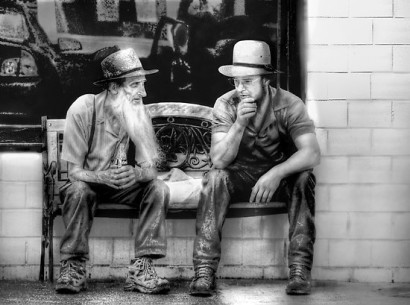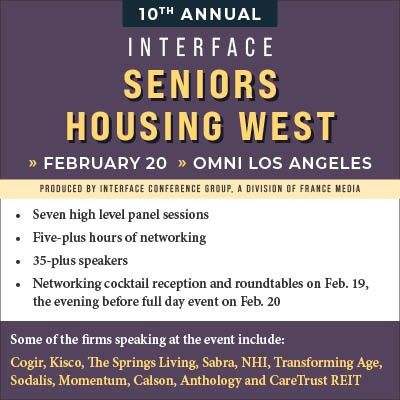Our modern age has created a jumble of ideas about how to approach our aging population. Some thoughts on that jumble.
Last week I attended the Bill Thomas Second Wind Tour in San Francisco, an event Dr. Thomas describes as non-fiction theatre. It was a slightly more low keyed event than I expected and completely full of hope and joy. I would recommend it as a worthwhile, well spent half day if the tour comes to you. I would add that the tickets have all been paid for by committed sponsors, so while they are not free, in the traditional sense they are a gift to you. Finally, and to my surprise and joy, while there were a handfull of sponsor tables this was not a pitch to sell anything.
The Wisdom of Elderhood
There was much emphasis on the wisdom of elderhood which particularly hit home for me. I can still remember how, when I was young, 65 was seen as old and this was, I think, more than just a view through very young eyes. It was so because there was not so much emphasis on perpetual adulthood that looks an awful lot like an attempt to turn life into perpetual late adolescent. It was a time when elders were seen as wise and special and caring, as people who had time to give back and nurture the young and the middle aged. There was no virtue in pretending to still be young when you were not. In fact, those who tried to delay adolescence were seen in negative eyes. Somehow we have ceased to see the wisdom and experience of getting older as something that has it’s own joys and values. This is unfortunate because those individuals who have significant track time on this earth have so so much they can teach younger generations. The very worst part of this whole thing is that most of us Boomers actually have bought the lie that elderhood is something to be dreaded, something to be avoided at any cost.
Telling the Truth
Somehow we need to embrace the truth. As we get older, there is stuff we can’t do as well as we could when we were younger. Sure, there are rugged healthy fit seniors doing amazing things like climbing Everest, including a 68 year old from my faith community right now. I admire him and and am even jealous of him. And, yet, that is not realistic or even desirable for most seniors. I hope and expect he will make it to the top, but he will work harder at it than those who are younger. He just doesn’t have the same capacity as those who are younger. The problem is that is as lose the capacity to climb mountains, party all night long day after day or work 16 hour days, we have come to believe that somehow we have lost value. This is just plain wrong.
So Much Wiser
I have done so many things in my life, met so many people, made so many mistakes and also done many things right. The big thing though is I am a lot smarter and wiser. I sort of have regrets that I didn’t start Senior Housing Forum until I was 56, but in truth I have serious doubts about how successful I would have been if I had started when I was younger. Somehow as a society and as an industry we need to find better ways to celebrate, evaluate and harness that wisdom. It is painful to say, but way too often I am afraid that we in the senior living industry are complicit in perpetuating the problem, which is the subject of part two. Steve
If you like this article (or even if you don’t) it would be a great honor to have you subscribe to our mailing list HERE









From LinkedIn Groups
It’s hard to regulate and assure quality and standards in an “assisted living-like” business. What you describe in your article is somewhat of a hybrid–not independent living, not assisted living. As you mention, people are waiting longer to move to a community and, by that time, usually need more services than independent living supplies. But, in a senior independent community by definition, the residents are offered certain services and amenities, but are generally able to take care of themselves so caregiving and medical services are not offered. Independent living is one step along the continuum of care. If you make it more like assisted living, then why not move the people to assisted living? Then, they would be more assured of receiving the services they need. I often see people living in an “independent” situation that obviously are not capable of living independently. I would rather see them getting enough care than living in a situation where more is needed but not receiving it.
By Regina Ford, MBA, CAPS
From LinkedIn Groups
Independent living facilites are going to be regulated soon in some states because the facilities are keeping people longer than they should without an evaluation process of the residents. Some facilities have evaulation processes in place, but most don’t. The injury rate will continue to climb because the residents can no longer take care of themselves.
By Ray Mead
From LinkedIn Groups
I concur with your thoughts about the sustainability of the current model. Adding in home care (health or companion) as part of community services is treating symptom rather that the problem, which in my opinion is a combination of out dated cultural models and management styles.
By G. Richard ‘Dick’ Ambrosius
From LinkedIn Groups
A pure, IL project for seniors with limited access to services or the ability to provide caregiving support is very much on life support. A number of the traditional IL projects that were more real estate and age focused are having severe occupancy issues (vacancy rates of 11-12%) and management which is out of touch with what there customers desire….which is to have a setting that is not boring and that allows them to not have to move multiple times. While regulation often prevents some of the living in place, IL is the new AL and the current AL has clearly moved into the SNF market.
By Michael Klatt
From LinkedIn Groups
Good question, Steve
Curiously, we see a growing number of independent living apartments without any significant support services. We have found these in small towns in Central PA, in Buffalo NY and elsewhere. They offer nice sized rental apartments and the ground floor of the building has a lot of common amenities where people can gather and socialize. They seem to fill quickly and are attracting a younger (early 70’s) market. There is another one in downtown Lancaster, PA that is owned by a well-know non-profit organization in the area. We are keeping an eye on this growing trend.
Keep asking the right questions.
Susan
By Susan B. Brecht
From LinkedIn Groups
I believe these communities are absolutely viable and serve a couple of different purposes. For one, if someone chooses to move to a new place to be near family or to a different client it provides a build in social and support system. Many other residents are in the same situation and friendships seem to form easily. To piggyback on that, I see many residents that help each other when tasks like shopping and laundry become too difficult. There often seems to be a sense of community that develops.
By Alison Emerick
from LinkedIn Groups
I concur with Alison. The biggest challenge for these communities, depending on the state guidelines, is as their acuity level changes that the community has the ability to provide resources for the residents to draw from so they can stay in the community. Some of these communities have residents that have medical issues that can put them beyond the support capabilities of the community and can create social or even safety issues for the other residents. This can be managed if the community is willing to provide a supp
From LinkedIn Groups
he market viability of independent living is tremendous. The plethora of available services, the professional management and marketing and the wonderful amenities and beautiful buildings create an incredibly positive environment for seniors. Empirical data supports the need, since occupancy rates consistently hover around 90%. And, FNMA, Freddie Mac and a cadres of commercial lenders love the product type. Cap rates are low, and rents are increased annually.
By Mark Myers
From LinkedIn Groups
Hi Steve, I operate in Canada where provincial regulations differ between provinces. Even within a province local health authorities play a role in where various lines are drawn and which models exist and what rights lie with the resident versus the operator. Simply defining IL across the country among peers is a challenge in itself let alone to banks and emergency services etc. The Colson era Holiday IL model I agree was pioneering but attempting that standardization today while possible might not be prudent. The reason isn’t interest in the lifestyle but instead because the more IL you position along the continuum the more likely you are to need to respond to the individuals. People want the price reductions of scale but servicing the individual is on the horizon and standardizations not likely inspiring; re. baby boomer. They are simply not going to be happy with efficiency kitchens and set meal times; unless budget is the only determining factor. Colloquial reflection leads me to models of cars, they evolve. Some simply impacted by fashions of the time and some by advances not previously available. It is the customer that will decide how successful a model is; whether behind the times or too slick to be understood just yet. Without a doubt, the blended model and AL registered IL suites is compelling right now and in an era where influencing children can’t/won’t provide the time and assistance themselves. However, while compelling it also becomes as complex as some of the needs now being serviced. Fiduciary responsibilities grow, influence of insurers impacts and regulators play influence. The pendulum swings, as they say. Many providers are simply expanding ‘retention’ tactics while some justify an expansion of service as part of their mission and promise to their residents. Others may say the opposite and the more honest approach is to not attempt to retain people in environments not built or suited to mobility challenges or where heavier ADL’s exist. I suspect viability is expanding in all directions with many more shades of each other yet to come. For IL ‘to work’ and be viable it requires in my opinion a resident to manage their own choices and care FOR THEMSELVES. THAT DOESN’T MEAN THEY NEED TO DO IT BY THEMSELVES. It is not only how ‘needy’ someone may become as how needy we make them in our services and environments. For IL ‘to work’ residents don’t want to be told, they want to be serviced and that is the evolving piece. Even the Holiday model was designed for efficiency and viability from the operation perspective out; i.e. set meal times, live-in mangers scheduled, no attendants on the floor past 8 pm etc. The modern IL environment will have to figure out the customer first model and I believe many are doing that these days. One thing remains certain for me, in all my years I have not met anyone inspired to go to care. A human being’s spirit, moral and vanity play as much to their happiness as healthy food and chemistry; many would say even more. Age is an irrelevant definer now in IL. The average age of the industry while climbing does not tell me the context of that data. We have communities where the ages are 67 to 102. Those are very different numbers and yet the lifestyle is appropriately IL with suites complete with full kitchens, self service bistros, one served multi-course meal, many still drive and a residents personal health files are their own concern. So, yes, I believe IL does still work, for those who don’t wait too long! 😉
By Graham Freeman
From LinkedIn Groups
Steve, this is a great article. Dr. Bill Thomas is a remarkable man and I’m so happy you had the chance to hear him speak. I wish everyone knew him. I shared this with my Facebook Caregiver Community and on Twitter. Thanks for sharing.
By Cindy Laverty
From LinkedIn Groups
Steve
Excellent article
I guess the point is we must keep doing things that keep us relevant or we start to fade away aging is a life reality and no need to run scared just except that working 16 hours and partying all night ain’t that smart anyway probably why as you get older it sounds less appealing and part of that is just getting smarter not older.
Thank you
By Pete Kici
From LinkedIn Groups
We need an Embrace Elderhood campaign and recognize the wisdom that comes with age.
By Rick Banas